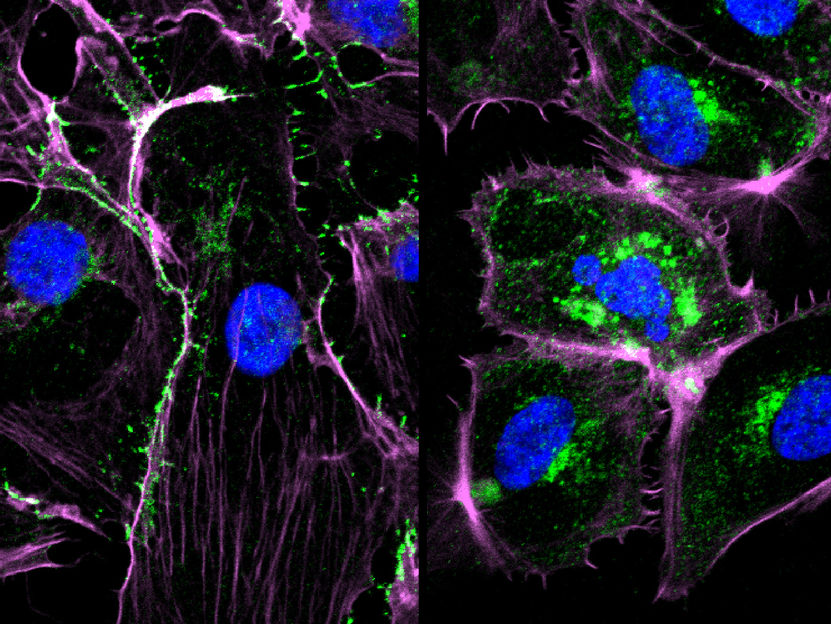Pseudomonas aeruginosa Bacteria produce a molecule that paralyzes immune system cells
Researchers from Freiburg and Strasbourg have discovered a strong immunological effect of the molecule LecB - and a way to prevent it
Advertisement
bacteria of the species Pseudomonas aeruginosa are antibiotic-resistant hospital germs that can enter blood, lungs and other tissues through wounds and cause life-threatening infections. In a joint project, researchers from the Universities of Freiburg and Strasbourg in France have discovered a mechanism that likely contributes to the severity of P. aeruginosa infections. At the same time, it could be a target for future treatments. The results were recently appeared in the journal EMBO Reports.

Human endothelial cells use the molecules cadherin (green) and actin (purple) to form a flexible barrier around blood vessels. After adding the isolated LecB, their localization in the cell changes significantly: in the right half of the image, cadherin is no longer on the outside of the cell, but near the nucleus (blue).
Yubing Guo / Universities of Freiburg and Strasbourg
Many bacterial species use sugar-binding molecules called lectins to attach to and invade host cells. Lectins can also influence the immune response to bacterial infections. However, these functions have hardly been researched so far. A research consortium led by Prof. Dr. Winfried Römer from the Cluster of Excellence CIBSS - Centre for Integrative Biological Signalling Studies at the University of Freiburg and Prof. Dr. Christopher G. Mueller from the IBMC - Institute of Molecular and Cell Biology at the CNRS/University of Strasbourg has investigated the effect of the lectin LecB from P. aeruginosa on the immune system. It found that isolated LecB can render immune cells ineffective: The cells are then no longer able to migrate through the body and trigger an immune response. The administration of a substance directed against LecB prevented this effect and led to the immune cells being able to move unhindered again.
LecB barricades the path for immune cells
As soon as they perceive an infection, cells of the innate immune system migrate to a nearby lymph node, where they activate T and B cells and trigger a targeted immune response. LecB, according to the current study, prevents this migration. “We assume that LecB not only acts on the immune cells themselves in this process, but also has an unexpected effect on the cells lining the inside of the blood and lymph vessels,” Römer explains. “When LecB binds to these cells, it triggers extensive changes in them.” Indeed, the researchers observed that important structural molecules were relocated to the interior of the cells and degraded. At the same time, the cell skeleton became more rigid. “The cell layer thus becomes an impenetrable barrier for the immune cells,” Römer said.
An effective agent against LecB
Can this effect be prevented? To find out, the researchers tested a specific LecB inhibitor that resembles the sugar building blocks to which LecB otherwise binds. “The inhibitor prevented the changes in the cells, and T-cell activation was possible again,” Mueller said, summarizing the promising results of the current study. The inhibitor was developed by Prof. Dr. Alexander Titz, who conducts research at the Helmholtz Institute for Pharmaceutical Research Saarland and Saarland University.
Further studies are needed to determine how clinically relevant the inhibition of the immune system by LecB is to the spread of P. aeruginosa infection and whether the LecB inhibitor has potential for therapeutic application. “The current results provide further evidence that lectins are a useful target for the development of new therapies, especially for antibiotic-resistant pathogens such as P. aeruginosa,” the authors conclude.
A cooperation across the Rhine
The results stem from a cooperation between the universities of Freiburg and Strasbourg. The two first authors of the study were or are currently doctoral candidates at both universities and were/are supported by the Franco-German University of Applied Sciences. The project is thus an example of a successful cross-border research project on the Upper Rhine.
Original publication
Janina Sponsel, Yubing Guo, Lutfir Hamzam, Emma Partiot, Quentin Muller, Julien Rottura, Raphael Gaudin, Dirk Hauck, Alexander Titz, Vincent Flacher, Winfried Römer, Christopher G. Mueller: Pseudomonas aeruginosa LecB suppresses the immune response by inhibiting transendothelial migration; EMBO Reports; 2023























































